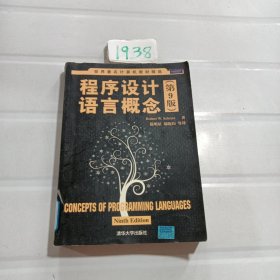
程序设计语言概念
¥ 18.91 3.9折 ¥ 49 九五品
仅1件
作者(美)西贝斯塔 主编
出版社高等教育出版社
ISBN9787040194111
出版时间2006-06
版次1
装帧平装
开本16开
纸张胶版纸
页数724页
字数99999千字
定价49元
上书时间2024-09-07
- 最新上架
商品详情
- 品相描述:九五品
- 商品描述
-
基本信息
书名:程序设计语言概念
定价:49.00元
作者:(美)西贝斯塔 主编
出版社:高等教育出版社
出版日期:2006-06-01
ISBN:9787040194111
字数:940000
页码:724
版次:1
装帧:平装
开本:16开
商品重量:
编辑推荐
内容提要
目录
Chapter 1 Preliminaries 1.1 Reasons for Studying Concepts of Programming Languages 1.2 Programming Domains 1.3 Language Evaluation Criteria 1.4 Influences on Language Design 1.5 Language Categories 1.6 Language Design Trade-offs 1.7 Implementation Methods 1.8 Programming Environments Summary·Review Questions·Problem SetChapter 2 Evolution of the Major Programming Languages 2.1 Zuse's Plankalkul 2.2 Minimal Hardware Programming: Pseudocodes 2.3 The IBM 704 and Fortran 2.4 Functional Programming: LISP 2.5 The First Step Toward Sophistication: ALGOL 60 2.6 Computerizing Business Records: COBOL 2.7 The Beginnings of Timesharing: BASIC Interview: ALAN COOPER--User Design and Language Design 2.8 Everything for Everybody: PL/I 2.9 Two Early Dynamic Languages: APL and SNOBOL 2.10 The Beginnings of Data Abstraction: SIM U LA 67 2.11 Orthogonal Design: ALGOL 68 2.12 Some Early Descendants of the ALGOLs 2.13 Programming Based on Logic: Prolog 2.14 History's Largest Design Effort: Ada 2.15 Object-Oriented Programming: Smalltalk 2.16 Combining Imperative and Object-Oriented Features: C 2.17 An Imperative-Based Object-Oriented Language: Java 2.18 Scripting Languages: JavaScript, PHP, and Python 2.19 A C-Based Language for the New Millennium: C# 2.20 Markup/Programming Hybrid Languages Summary·Bibliographic Notes·Review Questions .Problem SetChapter 3 Describing Syntax and Semantics 3.1 Introduction 3.2 The General Problem of Describing Syntax 3.3 Formal Methods of Describing Syntax 3.4 Attribute Grammars History Note 3.5 Describing the Meanings of Programs: Dynamic Semantics History Note Summary·Bibliographic Notes·Review Questions·Problem Set Programming ExercisesChapter 4 Lexical and Syntax Analysis 4.1 Introduction 4.2 Lexical Analysis 4.3 The Parsing Problem 4.4 Recursive-Descent Parsing 4.5 Bottom-Up Parsing Summary·Review Questions·Problem Set·Programming ExercisesChapter 5 Names, Bindings, Type Checking, and Scopes 5.1 Introduction 5.2 Names……Chapter 6 Data TypesChapter 7 Expressions and Assignment StatementChapter 8 Statement-Level Control StructuresChapter 9 SubprogramsChapter 10 Implementing SubprogramsChapter 11 Abstract Data Types and Encapsulation ConstructsChapter 12 Support for Object-Oriented ProgrammingChapter 13 ConcurrencyChapter 14 Exception Handling and Event HandlingChapter 15 Functional Programming LanguagesChapter 16 Logic Programming Languages
作者介绍
Robert Sebesta是科罗拉多大学科罗拉多泉分校计算机科学系的副教授。Sebesta教授在位于波尔德的科罗拉多大学获得应用数学专业学士学位,在宾西法尼亚州立大学获得计算机科学专业硕士和博士学位。他在讲授计算机科学课程方面具有超过34年的经验。他的专业兴趣在于程序设计语
序言
-

【封面】
相关推荐
— 没有更多了 —





















以下为对购买帮助不大的评价